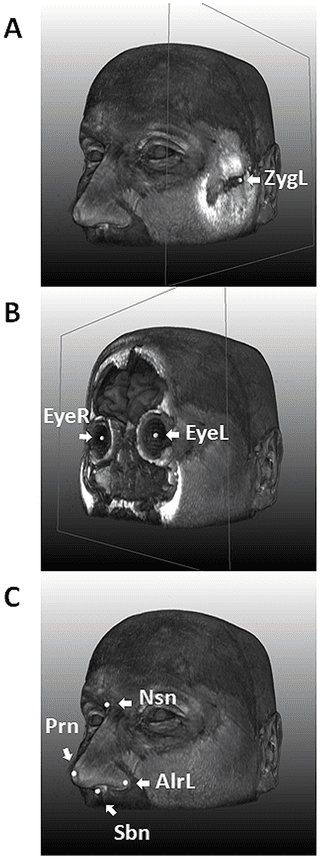
MRI of one of the authors (MK) is used for illustration. A, with the landmark for left zygion (ZygL) highlighted, where a clipping plane was used to uncover the bone; B, with the landmarks for left (EyeL) and right pupils (EyeR) highlighted, where a clipping plane was used to uncover the vitreous humor; C, with the four nasal landmarks highlighted, including the left alare, nasion (Nsn), pronasale (Prn), and subnasale (Sbn).
No person is the same, thanks to genetic variation. While skin color, hair, or body proportions are elements that might be exactly the same for two persons, you can be sure that one’s face is unique – even in identical twins, if you look extremely closely. While life style, body weight, diet, accidents and so on influence the shape and general appearance of one’s face, the classic elements like skin color, facial hair, the distance between eye sockets, symmetry, cheek bone and so on are entirely genetically driven. With this in mind, with a highly established genome map, scientists could be capable of recreating a person’s face based solely on his DNA sample, and this is exactly what an international team of researchers have been seeking out to do.
A wanted criminal could be identified much easier, based on the DNA ‘footprint’ he left behind at the crime scene and thus lead to a swifter apprehension. A victim of a calamity could be identified and offer peace to the family. Applications would be numerous, especially for secret services.
It’s worth noting, however, that this type of research is still in its infancy. So far, scientists have managed to pinpoint five genes (PRDM16, PAX3, TP63, C5orf50, and COL17A1) that contribute to facial shape and features, although they caution that the genes they found only have small effects, and are only linked with a limited number of features, limiting their use until more genes of relevance are found.
Predicting eye, hair and skin color are fairly well established, however where it truly gets complicated is in facial features. For instance, the researchers found that a certain gene called TP63 was a predictor of the gap between the centers of each eye socket being narrower by about nine millimeters. PAX3 contributes to facial shape variation at the genome-wide scale and so on. Once these parameters are well correlated and identified, facial features could be predicted just as accurate as eye or hair color can be today. If anything, something like a sort of portrait sketch could be recreated.
“It’s a start,” says Manfred Kayser from the Erasmus University Medical Center in Rotterdam, the Netherlands. “But we are far away from predicting what someone’s face looks like.”
Kayser and colleagues surveyed DNA samples from 10,000 Europeans and looked at nine specific facial “landmarks” in three-dimensional MRI scans of their heads. Another eight landmarks were subsequently analyzed, but from portrait photos.
Findings were published in the journal PLOS Genetics.









